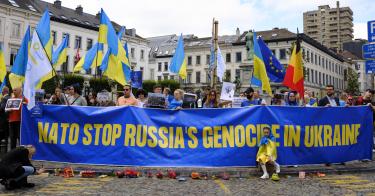Russia’s 2022 invasion of Ukraine served as a wakeup call to NATO, reversing a decades’ long trend of European members disarming at the end of the Cold War.
To that end, many (but not all) have been increasing their defense budgets and restarting weapons production lines—not only to supply Ukraine, but to enable a longer-term rearming of the European continent to deter potential future Russian aggression.
This is a welcome development, but we should not forget that in many ways, Europe’s security challenges are a direct consequence of its past decisions.
At the height of the Cold War in 1970, NATO fielded a military force that included over 10 million people in the active and reserve military (out of a population over 500 billion), with a combined Gross Domestic Product (GDP) of almost $2 trillion. This force included tens of thousands of aircraft, tanks, and artillery rounds, with nations such as Germany and the UK stationing hundreds of thousands of soldiers on the front lines of NATO, squaring off against the Warsaw Pact.
All of this was backed up by over 6,000 American tactical nuclear weapons stationed in Europe itself. In 1970, the United States committed 8% of its GDP on defense—more than twice the 3% the average European NATO member spent on defense. The end result: an effective—and, therefore, credible—military that deterred Soviet aggression.
>>> NATO in 2024—Can Its European Members Deter Further Russian Aggression?
By 2019, however, the situation in Europe was very different.
The totally military manpower had been cut in half, with NATO only fielding roughly five million people in NATO—and the United States provided almost all of these personnel. This was at a time when the population of NATO nations had almost doubled, to over 940 million.
And while the combined GDP of NATO in 2019 was over $40 trillion, European nations were spending only 1.5% of their GDP on defense—despite agreeing in 2006 to spend at least 2%. Perhaps most alarming of all, the United States maintained only about 100-150 tactical nuclear weapons in Europe, while Russia maintained over 2,000.
Why the change, in which a larger, more prosperous, and more technologically advanced Europe is unable to field a credible military deterrent in the face of Russian aggression? It isn’t because Russia is richer or has more people than Europe. Indeed, NATO’s economy—and its population size—is roughly seven times that of Russia.
The answer lies in European decisions. Many of those nations in Western Europe—particularly in Germany, France, Spain, Italy, and the United Kingdom—chose to underinvest in their militaries in order to provide robust social welfare benefits for their people. The consequence is a German Army (once the backbone of NATO’s ground forces in Europe) that is less than half the size of what it was when the Berlin Wall fell—despite having a population that is larger by 20 million people. The once-vaunted British navy only has 16 surface combatants remaining. Similar stories can be found across Western Europe.
This military weakness invited Russian aggression. Vladimir Putin, by all indications, respects strength and holds weakness in contempt. A Europe that outsourced its security to the United States was, if not an inviting target for Putin, was at least an opponent not to be feared by him.
>>> The Russia-North Korea Military Pact Is a Big Problem
The United States has been saying for almost 20 years that Europe needs to do more. In 2011, U.S. Secretary of Defense Robert Gates warned European leaders that “if current trends in the decline of European defense capabilities are not halted and reversed, future U.S. political leaders—those for whom the Cold War was not the formative experience that it was for me—may not consider the return on America’s investment in NATO worth the cost.” A decade and a half later, less than two-thirds of NATO members have reached that mark.
This represents a deep unseriousness on the part of many Europeans when it comes to security issues. Europe can either accept to live with a Russia that is able to outgun and therefore threaten Europe, or it can choose to re-arm and deter further Russian aggression within Europe. As noted earlier, many nations in Europe are already moving to higher defense budgets, but more must be done—and urgently.
The good news is that Europe has the resources to easily deter Russia. It has the required manpower, the wealth, the technology, and the industry.
It simply has to make the choice to do so.
This piece originally appeared in the National Security Journal





